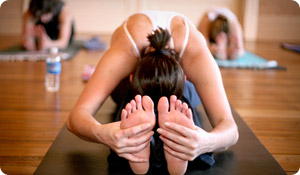
Yoga is often touted for building a strong body, mind, and spiritual connection. It's also praised as a cure for a long list of aches, pains, and chronic illnesses. What you may not have heard about are the injuries many endure as a result of practicing yoga. How can something so mellow result in so many accidents and injuries?
Ruth Knight manages the yoga program at The Movement Center in Portland, Oregon. Knight says, "While instructors shouldn't push students to do things that can cause injury, it's really up to the student to pay attention to what they can and can't do. Every instructor tells their students to listen to their own body and respect its' limits, but not every student actually does that." Knight goes on to state that it takes discipline to know your limits. Customize your movements to your body's needs and not the other way around. "I recommend when a student feels out of control, they talk to their instructor or reconsider if they're in the right class," Knight says.
Common Injuries
Joint strain, especially in the knees, wrists, ankles, shoulders, and neck are commonplace in many yoga practices. Students who have had previous injuries, aren't in great shape, are new to yoga, or don't practice proper technique (including with the use of props) are at especially high risk. Watch out for poses and yoga styles that put prolonged pressure on the feet, ankles, wrists, neck, and knees.
Practicing at high temperatures, like in Bikram Yoga studios, puts some students at risk for dehydration, heart and muscle strain. The studio is heated to approximately 105 degrees and classes run for 90 minutes. It's a strenuous practice of 26 poses, which makes this a popular style for athletes and people who prefer a vigorous, demanding exercise. The extra heat and resulting muscle relaxation, however, leaves some yogis vulnerable to pushing a pose too far, which can cause muscle strain and joint injury. Bikram isn't a good choice for some people with heart problems and those who are pregnant or have a hard time tolerating heat.
How to Avoid Injury
- Pick the right class. If you're new to yoga, try Hatha yoga for beginners.
- If you're pregnant or recovering from an injury or illness, pick a class that's customized for students with similar health issues.
- Tell your instructor about your health issues before class and ask for adjustments and accommodations to make poses safe for you.
- Some teachers are very "hands-on" with their students, even to the point of pushing, pulling, and swinging their students into proper alignment or to challenge them to do harder poses. If your instructor pushes you to do something you're uncomfortable with, say "no." Then, after class, talk to your instructor about how you feel. If necessary, pick a different teacher.
- If a pose is painful, especially in a joint area, release the pose to a less intense position or stop altogether. Ask your instructor for a variation or adjustment.
- Use props. Blocks, mats, straps and blanket rolls and chairs are available in most yoga studios, specifically to make yoga safe and accessible for everyone. Don't be ashamed to use them. Even yoga instructors use them sometimes.
Sources:
The Movement Center
Portland, OR
New York Times Magazine
How Yoga Can Wreck Your Body
By William J. Broad
Published: January 5, 2012





